
Background: The contamination of ecosystem compartments by microplastics (MPs) is an ubiquitous problem. MPs have been observed in mice tissues, and recently in human blood, stool and placenta. However, two aspects remain unclear: whether MPs accumulate in peripheral organs, specifically in the liver, and if liver cirrhosis favours this process. We aimed to examine human liver tissue samples to determine whether MPs accumulate in the liver. Methods: This proof-of-concept case series, conducted in Germany, Europe, analyzed tissue samples of 6 patients with liver cirrhosis and 5 individuals without underlying liver disease. A total of 17 samples (11 liver, 3 kidney and 3 spleen samples) were analyzed according to the final protocol. A reliable method for detection of MP particles from 4 to 30 µm in human tissue was developed. Chemical digestion of tissue samples, staining with Nile red, subsequent fluorescent microscopy and Raman spectroscopy were performed. Morphology, size and composition of MP polymers were assessed. Findings: Considering the limit of detection, all liver, kidney and spleen samples from patients without underlying liver disease tested negative for MPs. In contrast, MP concentrations in cirrhotic liver tissues tested positive and showed significantly higher concentrations compared to liver samples of individuals without underlying liver disease. Six different microplastic polymers ranging from 4 to 30 µm in size were detected. Interpretation: This proof-of-concept case series assessed the presence of MPs in human liver tissue and found six different MP polymers in the liver of individuals with liver cirrhosis, but not in those without underlying liver disease. Future studies are needed to evaluate whether hepatic MP accumulation represents a potential cause in the pathogenesis of fibrosis, or a consequence of cirrhosis and portal hypertension. Funding: No funding was received for conducting this investigator driven study.
